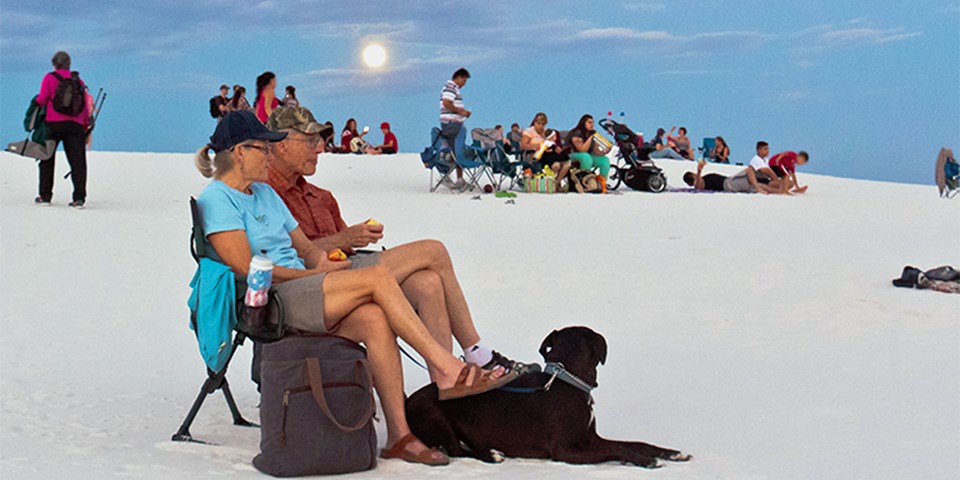
NPS Photo Enjoy the radiance of the dunes beneath a full moon with live music, ranger programs, and special guest presenters and artists. Full Moon Nights share the cultural legacy of Southern New Mexico and Northern Mexico, as well as the rich natural resources of White Sands National Park. The park hours will be extended two hours from the park's normal closing time on all Full Moon Nights for visitors to enjoy the full moon in the park on their own even when we will not being presenting a scheduled program. Full Moon Night Programs 2026
Full Moon Night Extended Park Hours 2026
WhereFull moon night programs are held in the amphitheater (Evening Program Area), which is a 7-mile (11.27 km) drive from the fee station. To get to the amphitheater, drive approximately six miles past the fee station to an intersection just beyond the Backcountry Camping Loop Trail parking lot. Take a right at that intersection and then the second left. Drive approximately one mile further and the amphitheater will be on the right side. CostProgram is free. Park entrance fees apply. Program lengthOne and a half to two hours. FitnessThere is an easy .25-mile (400 meters) walk from the parking area to the amphitheater. There are several gently sloping dunes in the amphitheater that may be climbed. AccessibilityThe amphitheater is an outdoor venue with a compact sand surface in most areas. For the full moon night programs, park staff set up a wheelchair and stroller accessible ramp near the stage. There are a limited number of designated spaces for persons with mobility concerns. Only vehicles displaying a disability placard or a disability license plate may park in these designated spaces. Service animals are allowed in all park facilities open to the general public. RestroomsThere are two vault toilet restrooms in the amphitheater area. Vault toilets are also available in other areas throughout the park. SeatingSeating is not provided at the amphitheater. You are encouraged to bring camp chairs, blankets, and coolers with food and drinks. Set up on the dunes that surround the amphitheater. PetsPets are allowed as long as they are non-disruptive, on a leash no longer than six feet (2 m), and under physical control at all times. Pets, like humans, should leave only footprints. Pick up after your pet(s) and Leave No Trace. Pets are not allowed in the visitor center. Programs may be canceled due to weather or missile range activities.Weather at the park can vary drastically and change quickly. The decision to cancel a program due to weather is rarely made more than 30 minutes before the program start time. Call the park at 575-479-6124 ext. 236 if you would like to confirm that a program is still scheduled. If the program is canceled, it will not be re-scheduled. ParkingThe amphitheater opens for parking one hour before the program start time. Full moon nights are very popular; expect a high volume of traffic. Allow an additional 30 minutes to drive from the fee station to the amphitheater area. Park rangers will direct you where to park once you arrive. Please drive slowly. When walking in and around the amphitheater area, please be mindful of moving vehicles and use the pedestrian walkways. Once the amphitheater parking area is full, the lot will be closed, and no other vehicles will be allowed to enter. Additional parking is allowed in the nearby pullout areas, refer to the Dunes Drive map for additional parking areas. At the end of the program, all vehicles must turn right when exiting to facilitate the orderly and safe departure from the amphitheater parking area. Buses and Large Passenger VansCommercial and recreational buses cannot park inside the amphitheater area due to space restrictions. Safety InformationThere are several safety considerations for the full moon night programs especially since these programs take place at night, and it can be very dark especially if there is cloud cover. Please…
Weather in the Tularosa Basin can change quickly. Temperatures can drop very quickly once the sun sets or during storms. Bring extra layers and be prepared for a variety of weather conditions. July through September is monsoon season. Storms can quickly build. Lightning often occurs in the desert during thunderstorms, even if there is no rain. Remember, when thunder roars, go indoors. Lightning often strikes the tallest object in the area. Avoid high points (top of a dune) and ground currents (tree roots).If you see a gathering storm or hear thunder, take cover in a metal-topped vehicle with your windows rolled up. Fold your hands in your lap and avoid touching metal objects in your car. |
Last updated: December 17, 2025
